The Bristol Blenheim marks the beginnings of one of the most notable aircraft lines in British history, culminating in the Beaufighter. The Blenheim started out as a high speed passenger and mail plane, but as the overtones of war started moving through Europe, the RAF quickly started looking for light bombers to complement its heavies. The Blenheim quickly was pressed into service as just such a plane, and once the Second World War broke out the Blenheim quickly entered combat. While the Blenheim was a great plane in the late 1930s, by the time 1940 rolled around it was outclassed by the opposing fighters. With the limited resources available to the RAF, though, there was no choice but to keep using the Blenheim. The RAF wasn't the only people to use the Blenheim, though, with some going to the Free French Air Force and some went to the Finnish Air Force. While the RAF suffered heavy losses with their Blenheims, the Finns used theirs to outstanding effect against the Russians. The Blenheim, while outclassed early on, continued serving in the RAF and other air forces throughout the Second World War and proved the durability of the airframe. Building on the best qualities of the Blenheim, Bristol went on to build the Beaufort and later the Beaufighter, giving the RAF and Coastal Command some of the best aircraft of the war. 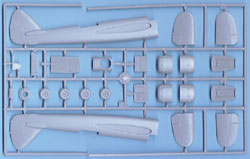 The Kit The Kit
If the above history text looks somewhat familiar, it's probably because you read my review of MPM's Blenheim Mk. IV in the November 2000 issue of Internet Modeler. In that review I mentioned that a Mk. I wouldn't be far behind. Well, here it is. The breakdown of the MPM kits makes it very easy to make the different marks of the Blenheim, and this kit shares a great number of common parts with the Mk. IV kit. In fact, aside from a new clear sprue, new PE, and different resin pieces, this kit is identical to the Mk. IV kit. 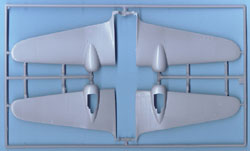 The breakdown of the parts will make some parts of assembly simple and provide potential problems in other areas. The most problematic area will be in the meeting of the clear nose pieces to the fuselage, as there's no tabs or locator pins used and the mating surfaces are very thin. Another potential problem is with the painting of the interior of these clear parts, as just painting the outside with the interior color won't work well here. I thought about hand-painting these parts, but I will likely end up painting some clear decal film with the interior color and using that to cover the inside framing. The breakdown of the parts will make some parts of assembly simple and provide potential problems in other areas. The most problematic area will be in the meeting of the clear nose pieces to the fuselage, as there's no tabs or locator pins used and the mating surfaces are very thin. Another potential problem is with the painting of the interior of these clear parts, as just painting the outside with the interior color won't work well here. I thought about hand-painting these parts, but I will likely end up painting some clear decal film with the interior color and using that to cover the inside framing.
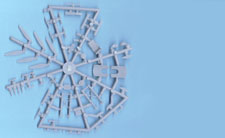 The cockpit is fairly well-detailed, with a PE instrument panel, resin cockpit floor, and a detailed rear bulkhead. There's room for improvement and if you have some good Blenheim references you can really go wild, and the large clear panels will show off any extra detailing. The cockpit is fairly well-detailed, with a PE instrument panel, resin cockpit floor, and a detailed rear bulkhead. There's room for improvement and if you have some good Blenheim references you can really go wild, and the large clear panels will show off any extra detailing.
The other main resin difference between the Mk.I and Mk.IV kits is the rear turret fairing piece. The one for the Mk.I has two indentations behind the turret, which is used for the Finnish example. For the other two options you use the regular plastic piece. You also get a couple choices of propeller hubs, again for use on the different versions. 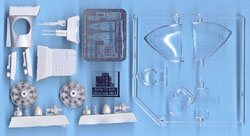 The decals are beautifully done and provide three choices. The first one is a Finnish example, camouflaged in the standard black and green over blue-gray. The lower wing outer sections are painted yellow, and the upper camouflage extends around the leading edge and back almost 1/3 of the way. The Finnish roundels have the centers removed from the swastikas, so you'll have to position those separately. The second choice is an RAF example from 1938, finished in brown and green uppers over black. Large white serials are on the lower wing. The final option is a Yugoslavian Blenheim, with the instructions stating the colors as Dark Earth, Dark Green, and Dark Brown over Blue Gray. The national markings consist of a roundel on the port upper wing and starboard lower wing, and colored bands on the rudder. The decals are printed by Cartograf out of Italy and are very well done. In fact, I can put them under a glass and read the Hamilton Standard logos for the propellers! The decals are beautifully done and provide three choices. The first one is a Finnish example, camouflaged in the standard black and green over blue-gray. The lower wing outer sections are painted yellow, and the upper camouflage extends around the leading edge and back almost 1/3 of the way. The Finnish roundels have the centers removed from the swastikas, so you'll have to position those separately. The second choice is an RAF example from 1938, finished in brown and green uppers over black. Large white serials are on the lower wing. The final option is a Yugoslavian Blenheim, with the instructions stating the colors as Dark Earth, Dark Green, and Dark Brown over Blue Gray. The national markings consist of a roundel on the port upper wing and starboard lower wing, and colored bands on the rudder. The decals are printed by Cartograf out of Italy and are very well done. In fact, I can put them under a glass and read the Hamilton Standard logos for the propellers!
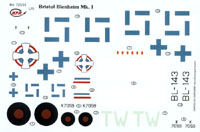 Conclusion Conclusion
With this release we now have just about every major Blenheim version available in 1/72, and hopefully MPM will come out with a Blenheim Mk. V in the near future. I'm going to build the Mk.I and Mk.IV side-by-side, since they share so much in common. This way when I do something wrong on one kit I'll be able to immediately correct it on the other one. By the time the Mk. V does come out, I'll be able to build it in my sleep! If you've been wanting to build a Blenheim but didn't want to tackle the Airfix kit, you'll be very pleased with the MPM kits. | 


 



  
    |
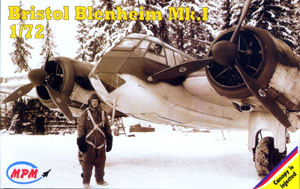
 The Kit
The Kit The breakdown of the parts will make some parts of assembly simple and provide potential problems in other areas. The most problematic area will be in the meeting of the clear nose pieces to the fuselage, as there's no tabs or locator pins used and the mating surfaces are very thin. Another potential problem is with the painting of the interior of these clear parts, as just painting the outside with the interior color won't work well here. I thought about hand-painting these parts, but I will likely end up painting some clear decal film with the interior color and using that to cover the inside framing.
The breakdown of the parts will make some parts of assembly simple and provide potential problems in other areas. The most problematic area will be in the meeting of the clear nose pieces to the fuselage, as there's no tabs or locator pins used and the mating surfaces are very thin. Another potential problem is with the painting of the interior of these clear parts, as just painting the outside with the interior color won't work well here. I thought about hand-painting these parts, but I will likely end up painting some clear decal film with the interior color and using that to cover the inside framing. The cockpit is fairly well-detailed, with a PE instrument panel, resin cockpit floor, and a detailed rear bulkhead. There's room for improvement and if you have some good Blenheim references you can really go wild, and the large clear panels will show off any extra detailing.
The cockpit is fairly well-detailed, with a PE instrument panel, resin cockpit floor, and a detailed rear bulkhead. There's room for improvement and if you have some good Blenheim references you can really go wild, and the large clear panels will show off any extra detailing. The decals are beautifully done and provide three choices. The first one is a Finnish example, camouflaged in the standard black and green over blue-gray. The lower wing outer sections are painted yellow, and the upper camouflage extends around the leading edge and back almost 1/3 of the way. The Finnish roundels have the centers removed from the swastikas, so you'll have to position those separately. The second choice is an RAF example from 1938, finished in brown and green uppers over black. Large white serials are on the lower wing. The final option is a Yugoslavian Blenheim, with the instructions stating the colors as Dark Earth, Dark Green, and Dark Brown over Blue Gray. The national markings consist of a roundel on the port upper wing and starboard lower wing, and colored bands on the rudder. The decals are printed by Cartograf out of Italy and are very well done. In fact, I can put them under a glass and read the Hamilton Standard logos for the propellers!
The decals are beautifully done and provide three choices. The first one is a Finnish example, camouflaged in the standard black and green over blue-gray. The lower wing outer sections are painted yellow, and the upper camouflage extends around the leading edge and back almost 1/3 of the way. The Finnish roundels have the centers removed from the swastikas, so you'll have to position those separately. The second choice is an RAF example from 1938, finished in brown and green uppers over black. Large white serials are on the lower wing. The final option is a Yugoslavian Blenheim, with the instructions stating the colors as Dark Earth, Dark Green, and Dark Brown over Blue Gray. The national markings consist of a roundel on the port upper wing and starboard lower wing, and colored bands on the rudder. The decals are printed by Cartograf out of Italy and are very well done. In fact, I can put them under a glass and read the Hamilton Standard logos for the propellers! Conclusion
Conclusion






